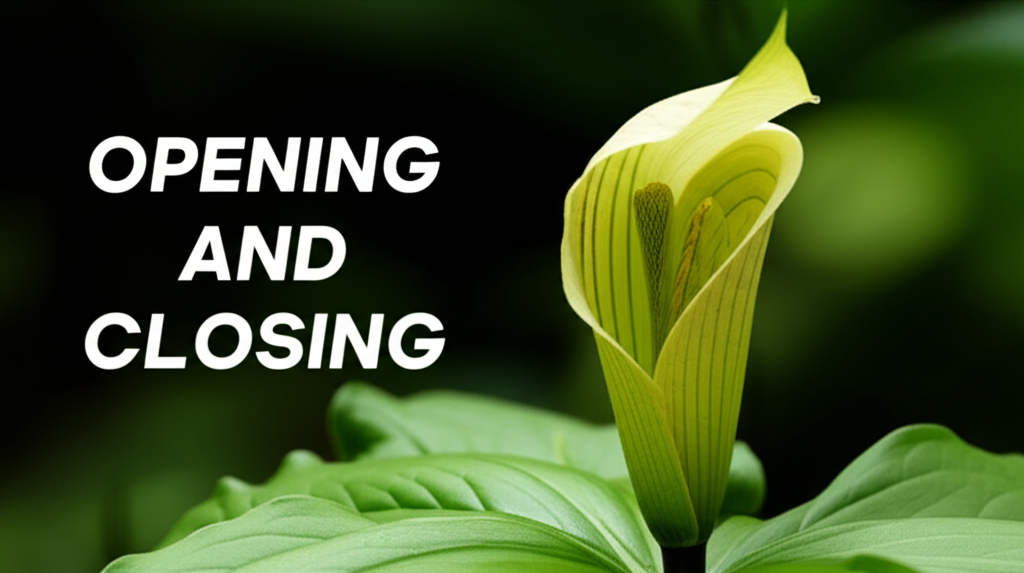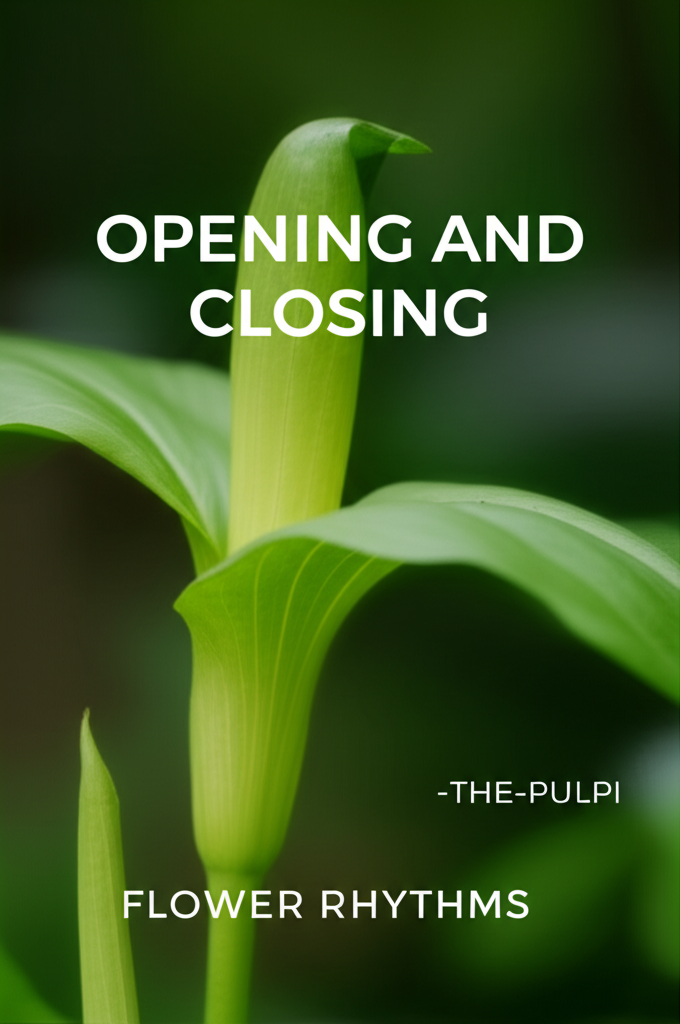Introduction to the Jack-in-the-Pulpit
The Jack-in-the-Pulpit (Arisaema triphyllum) is one of North America’s most distinctive and fascinating wildflowers. Its unique spathe, which encloses and partially conceals the spadix, truly resembles a preacher in a pulpit, hence its common name. Beyond its striking appearance, this woodland plant exhibits intriguing behaviors, including a fascinating, though often misunderstood, pattern of opening and closing. This article delves deep into the daily rhythm of the Jack-in-the-Pulpit, exploring the factors that influence its “opening” and “closing” times, and debunking common myths.
Understanding the Jack-in-the-Pulpit’s Structure

To understand its daily movements, it’s crucial to appreciate the anatomy of the Jack-in-the-Pulpit. The plant produces a single, erect flower stalk that arises from a corm. At the top of this stalk are three compound leaves. The reproductive structure, the inflorescence, is comprised of two main parts:
- The Spathe: This is the prominent, hooded leaf-like structure that surrounds the spadix. It is often green with purple or brown stripes, though variations exist. The spathe is the part that most people refer to when discussing the “opening” and “closing” of the Jack-in-the-Pulpit.
- The Spadix: This is the fleshy, club-shaped structure that emerges from the base of the spathe. It contains the tiny, often inconspicuous flowers. The spadix’s tip, or “jack,” protrudes from the opening of the spathe.
The spathe is not a true flower but a modified leaf. Its primary function is to protect the developing reproductive parts and, importantly, to attract pollinators. The “opening” and “closing” are not driven by a diurnal clock in the way a diurnal flower might be, but rather by a combination of growth, environmental cues, and reproductive strategy.
The Myth of Daily Opening and Closing
Many people imagine the Jack-in-the-Pulpit as a flower that opens with the morning sun and closes with the evening twilight, much like a daisy or a morning glory. However, this is a misconception. The Jack-in-the-Pulpit does not have a daily, predictable opening and closing cycle based solely on light. Instead, what appears as “opening” and “closing” is a more complex and gradual process related to its growth, pollination, and seed development.
Factors Influencing the Spathe’s Position
The seemingly dynamic behavior of the spathe is influenced by several factors:
1. Growth and Development
The most significant factor driving the spathe’s position is the plant’s growth. As the spathe unfurls from its protective sheath, it initially stands more upright, fully enclosing the spadix. Over time, as the plant matures and the reproductive phase progresses, the spathe will gradually droop and open wider. This is not a daily event but a stage in the plant’s life cycle.
2. Pollination and Seed Set
The primary purpose of the spathe and spadix is to facilitate pollination and subsequent seed production. The spathe’s structure creates a chamber that traps small insects, such as gnats and midges, which are the primary pollinators. These insects are lured into the spathe by scent and possibly by a slight warming of the spadix. Once inside, they are often trapped by downward-pointing hairs on the spadix. While attempting to escape, they pollinate the female flowers near the base of the spadix before reaching the male flowers further up.
After successful pollination, the spathe undergoes further changes. The downward-pointing hairs may wither, allowing the pollinators to escape. The spathe then continues to mature, and its position often changes, becoming more open and often drooping as the cluster of berries develops. This later stage can give the appearance of the plant “closing up” or becoming less accessible.
3. Environmental Conditions
While not a direct trigger for daily opening and closing, environmental conditions play a crucial role in the overall health and growth of the Jack-in-the-Pulpit, indirectly affecting the timing and extent of its spathe’s changes.
- Light: Jack-in-the-Pulpit thrives in shady, moist woodlands. While it doesn’t open or close based on daily light cycles, adequate sunlight is necessary for its growth and energy production, which in turn fuels the development of its reproductive structures.
- Moisture: Consistent moisture is vital. Drought conditions can stress the plant, affecting its ability to develop and display its spathe properly.
- Temperature: The plant emerges in late spring, with flowering typically occurring from April to June, depending on the geographical location and specific microclimate. Temperature influences the rate of growth and development.
4. Insect Activity
The attraction and trapping of pollinators are directly linked to the spathe’s opening. If conditions are unfavorable for insect activity (e.g., heavy rain, extreme cold), pollination may be less successful, and the spathe’s opening might not proceed as intended.
Key Stages of the Jack-in-the-Pulpit’s Flowering Cycle
Instead of daily opening and closing, it’s more accurate to view the Jack-in-the-Pulpit’s spathe as going through distinct developmental stages throughout its flowering and fruiting season.
Stage 1: Bud and Early Unfurling
In late spring, the plant emerges from the ground. The spathe, initially tightly rolled, begins to unfurl. It stands upright, with the hood arching over the spadix. At this stage, the opening between the spathe and spadix is narrow, providing a protected environment for the developing flowers.
Stage 2: Pollinator Attraction and Trapping
As the spathe fully unfurls and matures, it becomes receptive to pollinators. The scent and internal structure are designed to lure insects. The opening may appear more prominent at this stage, allowing access for insects. The spadix may also slightly warm, further attracting insects.
Stage 3: Post-Pollination and Seed Development
After pollination has occurred (typically over a period of days or weeks), the spathe undergoes further changes. The downward-pointing hairs on the spadix usually wither, and the spathe itself begins to change. It may start to droop, and the opening can widen significantly. This allows trapped insects to escape and also accommodates the developing berries.
Stage 4: Berry Formation and Seed Dispersal
By late summer or early autumn, the spathe has often withered and may be barely recognizable. The true spectacle at this stage is the cluster of bright red berries that form from the fertilized ovaries at the base of the spadix. The berries contain the seeds, which are dispersed by birds.
Distinguishing “Open” vs. “Closed” Appearances
When people refer to a “closed” Jack-in-the-Pulpit, they are usually observing the plant in its early stages of development, when the spathe is tightly wrapped around the spadix and stands upright. A “fully open” Jack-in-the-Pulpit is typically observed after pollination has occurred, when the spathe has widened and begun to droop, revealing more of the spadix and the developing berries.
Comparison Table: Jack-in-the-Pulpit vs. Diurnal Flowers
To further clarify the unique nature of the Jack-in-the-Pulpit’s movement, here’s a comparison with flowers that exhibit true daily opening and closing:
| Feature | Jack-in-the-Pulpit (Arisaema triphyllum) | Diurnal Flower (e.g., Morning Glory, Daisy) |
|---|---|---|
| Primary Trigger for Movement | Growth, reproductive stage, pollination success | Light intensity (photoperiodism), temperature |
| Nature of Movement | Gradual unfurling, drooping, and widening over days/weeks | Rapid opening and closing, often daily |
| Daily Cycle | No predictable daily opening/closing | Clear daily cycle (opens morning, closes evening) |
| Purpose of Movement | Pollinator attraction and trapping, seed development | Maximizing sunlight exposure for photosynthesis, protecting reproductive parts at night |
| Structure Involved | Spathe (modified leaf) | Petals (modified leaves) |
Why This “Opening” and “Closing” Matters
Understanding the true nature of the Jack-in-the-Pulpit’s spathe movement is important for several reasons:
1. Accurate Botanical Understanding
It corrects a common misunderstanding of plant behavior, fostering a deeper appreciation for the intricate strategies plants employ for survival and reproduction.
2. Conservation Efforts
Knowing the plant’s lifecycle and environmental needs is crucial for effective conservation. Understanding that its “opening” is a developmental process, not a daily event, helps in habitat restoration and protection.
3. Ecological Significance
The Jack-in-the-Pulpit plays a role in its ecosystem. Its unique pollination mechanism and eventual berry production provide resources for insects and birds. Disrupting its natural processes could have ripple effects.
4. Appreciation of Nature’s Wonders
The subtle yet complex dance of the Jack-in-the-Pulpit is a testament to the ingenuity of evolution. Appreciating these nuances enriches our connection with the natural world.
Steps Involved in the Spathe’s Transformation and Key Considerations
The transformation of the Jack-in-the-Pulpit’s spathe is a process. Here’s a breakdown of the general stages and crucial factors:
| Step/Stage | Description | Pros | Cons |
|---|---|---|---|
| Emergence & Budding | Plant emerges from corm, spathe tightly furled. | Protects developing floral structures. | Limited visibility of reproductive parts. |
| Unfurling & Upright Position | Spathe gradually opens, standing erect, hood arching. | Initial exposure to attract pollinators. | Still somewhat protected, potentially limiting direct access. |
| Pollinator Attraction & Trapping | Scent, warmth (slight), and internal structure lure insects. | Efficient mechanism for targeted pollination. | Risk of trapping non-target insects or too many. |
| Post-Pollination & Maturation | Spathe begins to droop, opening widens, hairs wither. | Allows pollinators to escape, facilitates berry development. | Increased vulnerability to damage. |
| Withered Spathe & Berry Display | Spathe decays, revealing prominent red berries. | Attractive to seed-dispersing animals (birds). | Plant energy now focused on seed production, not further flower display. |
When Can You Best Observe This Transformation?
The ideal time to witness the unfolding story of the Jack-in-the-Pulpit is during the spring and early summer months.
- Late April to May: This is typically when the plant emerges and the spathe is in its upright, partially unfurled stage. You might observe the initial opening.
- Late May to June: During this period, the plant is most likely to be actively attracting pollinators. You may see insects entering the spathe. The spathe might be at its most “open” in terms of accessibility, though still erect or slightly leaning.
- July onwards: As pollination concludes, the spathe will begin its transition to a drooping, withered state, with the developing berries becoming the focal point.
It’s important to remember that these are general timelines and can vary significantly based on your geographic location, the local climate, and the specific microhabitat within the woods. Observing a single plant over several weeks will provide the best understanding of its individual journey.
Conclusion
The Jack-in-the-Pulpit’s daily schedule is not dictated by the sun’s rise and set, but by the intricate biological imperatives of growth, reproduction, and pollination. Its “opening” and “closing” are not fleeting daily events but rather gradual transformations within a complex life cycle. By understanding these processes, we gain a deeper appreciation for this captivating woodland inhabitant and the sophisticated strategies employed by nature. The Jack-in-the-Pulpit remains a true marvel, its silent, purposeful movements a testament to the enduring mysteries and wonders of the plant kingdom.


